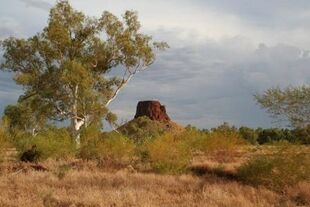Earth:Pannawonica, Western Australia
| Pannawonica Western Australia | |||||||||
|---|---|---|---|---|---|---|---|---|---|
 Pannawonica Hill | |||||||||
| Script error: No such module "Australian place map". | |||||||||
| Coordinates | [ ⚑ ] : 21°38′00″S 116°20′00″E / 21.6333333°S 116.3333333°E | ||||||||
| Population | 695 | ||||||||
| Established | 1970 | ||||||||
| Postcode(s) | 6716 | ||||||||
| Elevation | 200 m (656 ft) | ||||||||
| Location |
| ||||||||
| LGA(s) | Shire of Ashburton | ||||||||
| State electorate(s) | North West Central | ||||||||
| Federal Division(s) | Durack | ||||||||
| |||||||||
The town of Pannawonica is an iron-ore mining town located in the Pilbara region of Western Australia, near the Robe River, about 200 km south-west from Karratha and 1429 km North from Perth. At the 2016 census, Pannawonica had a population of 695.[1]
In 2011 and again in 2016, it reportedly had the highest median weekly income of any town in Western Australia and most likely Australia, due to the high income of its mine workers.[2]
History
Pannawonica was built on Yalleen Station in 1970 by Cleveland-Cliffs Robe River Iron (it then became Robe River Iron Associates and was then bought out by Rio Tinto Iron Ore) it was gazetted as a townsite in 1972.
The township’s name was derived from nearby Pannawonica Hill, named by a surveyor in 1885 after the corresponding Aboriginal placename which is said to mean "the hill that came from the sea". The traditional legend is that two local Aboriginal tribes were arguing over the ownership of the hill which was located by the sea. The sea spirit decided to resolve the dispute by moving the hill inland. As the hill was dragged over the land it left a deep indentation which became the Robe River.
Pannawonica is one of a number of remote-area iron-ore-mining towns built throughout the Pilbara to house workers operating open-cut mines and the loading of ore trains. It is a 'closed town', having limited facilities for visitors, the company's accommodation being reserved for its staff and visiting contractors. Some visitor accommodation is available at the Pannawonica Tavern.
Pannawonica is home to more than 1000 people: Rio Tinto Iron Ore employee families, staff on fly-in fly-out (‘fifo’) roster from Perth, and those involved in support services (49% residential, 51% FIFO). It is accessible by road, rail and light aircraft.
Climate
Pannawonica’s weather is recorded by the Australian Bureau of Meteorology station number 005069, which was opened in 1971. Between 1971 and 2005, the mean maximum temperature at Pannawonica ranged from 26.7 °C in July to 40.9 °C in January. Pannawonica experiences a wet season that can stretch from December to March, and cyclonic storm events.
Resident facilities
The town’s facilities include a post office, supermarket, milk-bar, pub, a public swimming pool, sports fields, police station, petrol station, primary school, tavern bistro, gym and a free drive-in cinema with takeaway facility, free movies show on Friday and Sunday nights. Police officers based at Pannawonica supervise an area of approximately 33,800 square kilometres.
The annual Pannawonica Robe River Rodeo, in September, attracts an average of 1500 people from all over Australia. Funds raised are distributed to many organisations including the Royal Flying Doctor Service, local school and other volunteer-based groups.
An annual Gala weekend held around August boasts a Gala Ball evening to raise funds for a Family Fun Day with children's rides and local stallholders showcase their wares.
Mining and loading
The Pannawonica residents work at the nearby Mesa J opened in 1992, Mesa A mines opened in 2010 and Warramboo still in development. Mesa is a Spanish word that means ‘table’, which describes the appearance of the flat-topped iron-ore plateaus standing high above the surrounding ground, remnants of terrain carved by an ancient river system.
The Robe Valley operation produces two pisolite (spheroidal crystalline) iron-ore products called Robe River Fines and Robe River Lump. The blasted high-grade ore is hauled directly to a train load-out. The sub-grade ore is washed and screened prior to loading onto trains that can stretch for three kilometres. Rio Tinto Iron Ore - Robe Valley transports about 32 million tonnes of iron ore per year via the company’s private 200-kilometre-long rail line to its processing and port facilities at Cape Lambert, near the township of Wickham.
References
- ↑ "2016 Census QuickStats: Pannawonica" (in en). http://www.censusdata.abs.gov.au/census_services/getproduct/census/2016/quickstat/SSC51188.
- ↑ Salt B Richest and poorest live in outback towns The Australian Business, 27 November 2008
External links
Western Australian Land Information Authority. "History of country town names – P". http://www0.landgate.wa.gov.au/maps-and-imagery/wa-geographic-names/name-history/historical-town-names#P.

